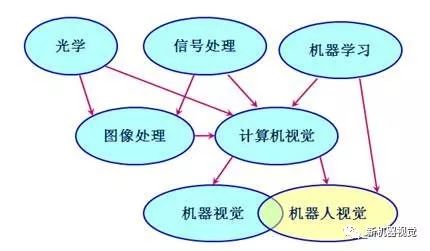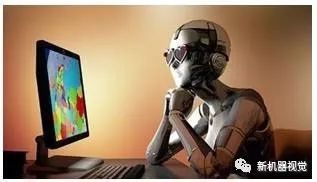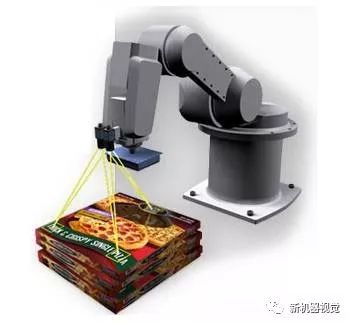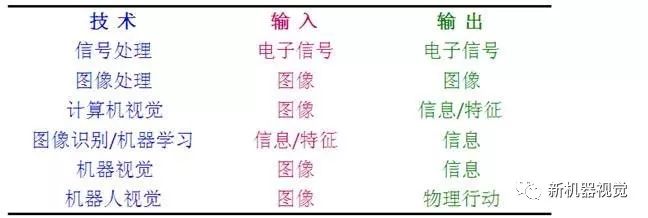Click on the above“Beginner’s Guide to Vision” and select to add a Bookmark or Pin.
Important content delivered promptly
Robot vision, computer vision, image processing, machine vision, and pattern recognition, what are the differences between these terms? It can sometimes be confusing to understand which is which. Next, let’s take a look at the specific meanings of these terms and their relationship with robotics technology. After reading this article, you will no longer be confused by these concepts! In this article, we break down the “genealogy” of robot vision to show its position in the broader field of signal processing.
What is Robot Vision
Robot Vision
Robot vision refers to the systems that enable robots to have visual perception capabilities, and is one of the important components of a robotic system. In basic terms, robot vision involves the combination of camera hardware and computer algorithms that allow robots to process visual data from the real world. For example, your system may enable a 2D camera to detect an object that the robot is about to pick up; a more complex example might involve using a 3D stereo camera to guide a robot in attaching a wheel to a moving vehicle.
Without machine vision, your robot is essentially blind. This may not be an issue for some robotic tasks, but for certain applications, robot vision is helpful and even essential.
The Genealogy of Robot Vision
Robot vision is closely related to machine vision, which we will introduce later. Both of these are closely related to computer vision, which can be seen as their parent in the genealogy diagram. However, to understand their position in the entire system in detail, we need to further introduce their grandparents – signal processing.

Genealogy
Signal Processing
Signal Processing
Signal processing includes handling electronic signals, cleaning (e.g., denoising), extracting information, preprocessing for output to display, or preparing for further processing. Anything can be a signal, more or less, with various types of signals that can be processed, such as analog signals, digital signals, frequency signals, etc. Images are essentially just two-dimensional (or more-dimensional) signals, and for robot vision, we are interested in processing images.
Image Processing vs Computer Vision
Image Processing vs Computer Vision
Computer vision and image processing are like cousins, but they have very different goals. Image processing techniques are primarily used to enhance the quality of images, convert them into another format (e.g., histograms), or modify them for further processing. On the other hand, computer vision focuses more on extracting information from images to perceive them. Therefore, you might use image processing to convert a color image to a grayscale image, and then use computer vision to detect objects within that image. Looking further up this genealogy, we see that both fields are greatly influenced by the physical sciences, especially optics.
Pattern Recognition and Machine Learning
Pattern Recognition and Machine Learning
So far, things have been straightforward. When we add pattern recognition or the broader field of machine learning to the genealogy, things start to get a bit complex. This branch focuses on recognizing patterns in data, which is quite important for more advanced functionalities needed in robot vision. For example, in order to recognize an object from its image, the software must be able to detect whether the object it sees is one it has seen before. Thus, machine learning is another parent of computer vision aside from signal processing.
However, not all computer vision techniques require machine learning; you can also use signals instead of images for machine learning and input them into machine learning algorithms. For example, computer vision detects the size and color of parts on a conveyor belt, and then machine learning determines whether these parts are defective based on knowledge learned from what normal good products should look like.

Machine Vision
Machine Vision
Now we talk about machine vision, and everything will change. This is because machine vision is entirely different from the terms previously discussed. It focuses more on specific applications rather than just the technical aspects. Machine vision refers to the use of vision for industrial purposes for automatic inspection, process control, and robotic guidance. The rest of the genealogy belongs to the scientific field, while machine vision is an engineering field.
To some extent, you can think of machine vision as a child of computer vision because it uses the technologies and algorithms of computer vision and image processing. However, while it can be used to guide robots, it is not entirely robot vision.
Robot Vision

Robot Vision
Finally, we arrive at robot vision. If you have been following along with this article until now, you will realize that robot vision incorporates all the previously discussed technologies. In many cases, robot vision and machine vision are used interchangeably. However, there are some subtle differences; some machine vision applications, such as part monitoring, are unrelated to robots, where the workpiece is simply placed in front of a visual sensor used to detect defects.

Machine Vision vs Robot Vision
Moreover, robot vision is not only an engineering field; it is also a scientific discipline with its specific research areas, distinct from pure computer vision research. Robot vision must incorporate robotics technology into its techniques and algorithms. Visual servoing is a perfect example of a technology referred to as robot vision rather than computer vision. It involves motion control of robots using feedback from visual sensors to detect the robot’s position.
Inputs and Outputs
To conclude this article, below is a summary of the basic inputs and outputs of each of the terms introduced above.

Good news!
The Beginner's Guide to Vision Knowledge Planet
is now open to the public👇👇👇
Download 1: OpenCV-Contrib Extension Module Chinese Tutorial
Reply "Chinese Tutorial for Extension Module" in the "Beginner's Guide to Vision" WeChat account backend to download the first OpenCV extension module tutorial in Chinese, covering installation of extension modules, SFM algorithms, stereo vision, object tracking, biological vision, super-resolution processing, and more than twenty chapters of content.
Download 2: Python Vision Practical Project 52 Lectures
Reply "Python Vision Practical Project" in the "Beginner's Guide to Vision" WeChat account backend to download 31 practical vision projects including image segmentation, mask detection, lane detection, vehicle counting, eyeliner addition, license plate recognition, character recognition, emotion detection, text content extraction, and facial recognition, to help you quickly learn computer vision.
Download 3: OpenCV Practical Projects 20 Lectures
Reply "OpenCV Practical Projects 20 Lectures" in the "Beginner's Guide to Vision" WeChat account backend to download 20 practical projects based on OpenCV for advanced learning.
Group Chat
Welcome to join the WeChat reader group to communicate with peers. Currently, there are WeChat groups for SLAM, 3D vision, sensors, autonomous driving, computational photography, detection, segmentation, recognition, medical imaging, GAN, algorithm competitions, etc. (these will gradually be subdivided). Please scan the WeChat number below to join the group, and note: "Nickname + School/Company + Research Direction", for example: "Zhang San + Shanghai Jiao Tong University + Vision SLAM". Please follow the format; otherwise, the request will not be approved. After successful addition, you will be invited to relevant WeChat groups based on your research direction. Please do not send advertisements in the group; otherwise, you will be removed. Thank you for your understanding~
